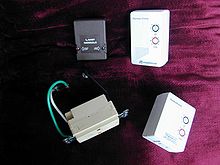X10 (protocol)
When X10 is a power line based network protocol for building automation , in which the switching signals are sent through the existing house wiring (115/230 V, 60 Hz (US) or 230/400 V, 50 Hz (Europe)) without new lines must be relocated. It can be used to automate and remote control simple switching processes. The switches or control elements are either permanently installed or plugged into sockets and communicate with one another via 120 kHz control signals. These are only sent during the zero crossings of the AC voltage to increase switching reliability and to avoid interference from phase control (dimmer) . The concept is similar to that of the newer versions that enable home appliance networking via the power line. However, these use other signal transmission methods (two frequencies, spread spectra and others) that are less susceptible to interference and enable a higher signal transmission rate. In addition to the purely power grid-based elements, there are also remote controls and control elements based on radio frequency for the X10.
history
The X10 protocol was developed in mid-1975 by Pico Electronics in Scotland ( Great Britain ) and promoted by General Electric . It was therefore mainly used in the USA. The chips were marketed by the X-10 Group in Hong Kong , which at the time was still under British administration. In Germany, a license was acquired from the Busch-Jaeger company in Lüdenscheid , which marketed the technology under the Busch Timac X-10 in Germany until around 1990, but later increasingly switched to the European installation bus ( EIB wired or EIB Powernet).
Large-scale applications of the Timac-X10 were implemented at the end of the 1980s by Enertech from North Rhine-Westphalia under the direction of Detlef Harpers by using the X-10 protocol only to switch off superfluous energy consumers (up to 1300 switching points). Here, 35 percent energy savings were achieved in schools without even laying a new wire.
The main disadvantage of the X10 protocol is actually not the low data transfer rate or the address space that is limited to 256 channels (light switches, roller shutter controls, thermostats and so on). The protocol did not provide for any feedback, so that higher-value tasks that required switching reliability (e.g. reliable fault messages) could not be carried out.
In Germany, two main problems made it difficult to use X-10:
- the normal household three-phase network
- the low permitted line-bound signal strengths. X-10 could only be operated legally below the 5 mW transmission power limit .
The actually properly functioning devices had to be lowered in their transmission power in Germany for approval so that plug and play operation was almost impossible. An electronic ballast for fluorescent lamps, for example, was able to cover the X-10 signal with the permitted 5 mW.
Furthermore, the integrated circuits had no level control - with just under 300 mW transmission power, they were able to cope with all impedance fluctuations in the power grid at 120 kHz. The devices, which were lowered to 5 mW for Germany, therefore had no level control - every radio interference suppression capacitor , no matter how small, was the sure failure of the signal.
The three-phase three-phase network is almost unknown in the Anglo-Saxon region. Nevertheless, the developer had taken this into account as a precaution when drafting the protocol and repeated the signals every 120 ° after the zero crossing, so that all control impulses were found in all phases at the zero crossing. For this purpose, the signals must be transmitted in three-phase installations between the three outer conductors by coupling elements so that a signal transmitted on one of the phases can reach a consumer on another phase. In the USA there are only single-phase house installation networks - and therefore there were no problems in this regard either. General Electric has marketed X-10 quite successfully to this day.
Alternative control protocols (such as CEBus ) have also been developed in the USA to automate larger buildings . Because of the low acquisition costs, X10 devices continued to gain popularity in the USA. This in turn meant that not only newly developed X10 devices came onto the market, but also that the protocol was expanded for new functions, and that X10 achieved a high degree of penetration in private home automation in the USA.

This development in the USA made the X10 interesting again in Europe. Although the devices only transmit at zero crossing regardless of the mains frequency, the cost-effective American X10 devices could not be used in Germany due to the different mains voltage (and the lack of approval). It is different with the American home automation software. It can also be used in Germany in conjunction with X10 devices. With regard to the receiver, more powerful X10 devices for 230 V, 50 Hz with CE approval are offered by several European companies and are now also available again in Germany. Small X10 receivers that can be installed in the switch and junction boxes of the house installation are of particular interest, so that the switch to house automation is possible without major changes to the existing installation.
The above-mentioned problems with electronic ballasts in the consumers to be controlled (e.g. energy-saving lamps, fluorescent tubes or LED light sources) are no longer a problem with the current European X-10 products.
literature
- Mike Riley: The Smart House. Home automation with Arduino - Android and PC, O'Reilly Verlag, Cologne 2012, ISBN 978-3-86899-363-9 .
- Bernd Aschendorf: Energy management through building automation. Basics - Technologies - Applications, Springer Fachmedien, Wiesbaden 2014, ISBN 978-3-8348-0573-7 .
- Tom Igoe: Making Things Talk. 1st edition, O'Reilly Verlag, Cologne 2012, ISBN 978-3-86899-162-8 .
